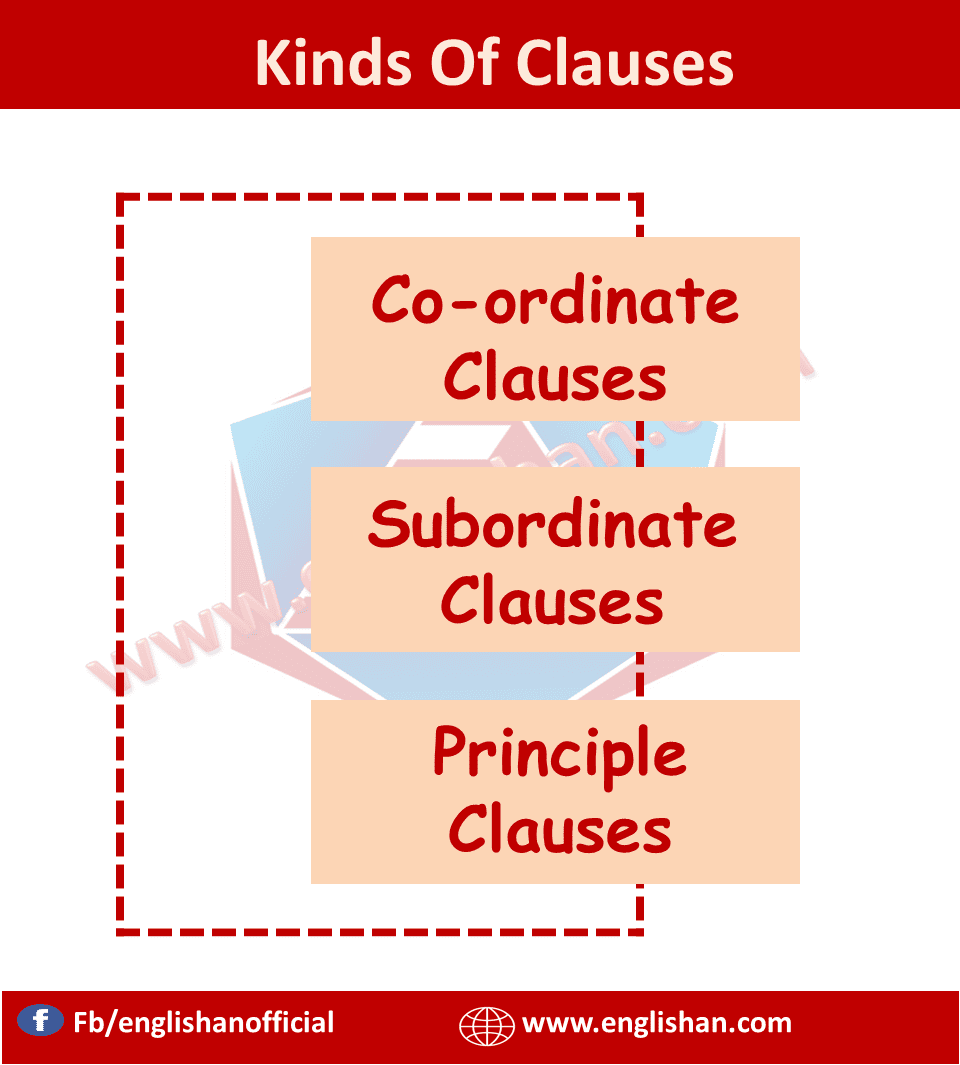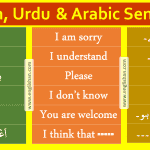Clause Analysis, Kinds of Clauses, Clause Examples, Subordinate clause, Principal Clause, Co-ordinate Clauses, Adverb Clause, Adjective Clause, Noun Clause with Complete Explanation, Analysis, and Functions
What is a Clause?
Those parts of a sentence that have subjects and predicates are called Clauses. There are as many clauses in a sentence as there are Finite Verbs.
Examples:
- She knows where you live. (Knows what?)
- She knows the place where you live. (Which place?)
- She will reach where you live. (Shall reach where?)
Explain:
1. She knows where you live.
- Main Clause: “She knows where you live.”
- This is an independent clause that can stand alone as a complete sentence. It has a subject (“She”) and a verb (“knows”).
- Subordinate Clause: “where you live”
- This is a noun clause acting as the direct object of the verb “knows.” Noun clauses can act as subjects, direct objects, indirect objects, or objects of prepositions.
- The noun clause here is also an adverbial clause of place, providing information about the location related to the verb “knows.”
- Type of Subordinate Clause: Adverbial Clause of Place
- This clause answers the question “where” in relation to the verb “knows.”
2. She knows the place where you live.
- Main Clause: “She knows the place.”
- Like the first example, this is an independent clause with its own subject and verb.
- Subordinate Clause: “where you live”
- Here, the clause acts as an adjective clause, modifying the noun “place.” Adjective clauses provide more information about a noun and usually start with a relative pronoun (who, whom, whose, which, or that) or a relative adverb (where, when, why).
- Type of Subordinate Clause: Adjective Clause
- The clause provides additional description for “the place,” specifying which place is being referred to.
3. She will reach where you live.
- Main Clause: “She will reach.”
- This is another independent clause, with a subject (“She”) and a verb phrase (“will reach”).
- Subordinate Clause: “where you live”
- Similar to the first example, this is a noun clause acting as the direct object of the verb “will reach.” It is also an adverbial clause of place, providing location information.
- Type of Subordinate Clause: Adverbial Clause of Place
- This clause provides information about the location related to the verb “will reach.”
Kinds of Clauses
- Co-ordinate Clauses
- Subordinate Clauses
- Principal Clauses
Co-ordinate Clauses
- The bus arrived and I boarded it.
- Run fast or you will lose the race.
- He ran fast but (he) lost the race.
The above sentences are joined by co-ordinate conjunctions e.g. and, or an but’. They are the examples of Co-ordinate clauses.
Some more Co-ordinate Conjunctions are: not only but also; either or, neither nor, or else; otherwise, as well tis, for, therefore, bot, and, etc. They also join Co-ordinate Clauses.
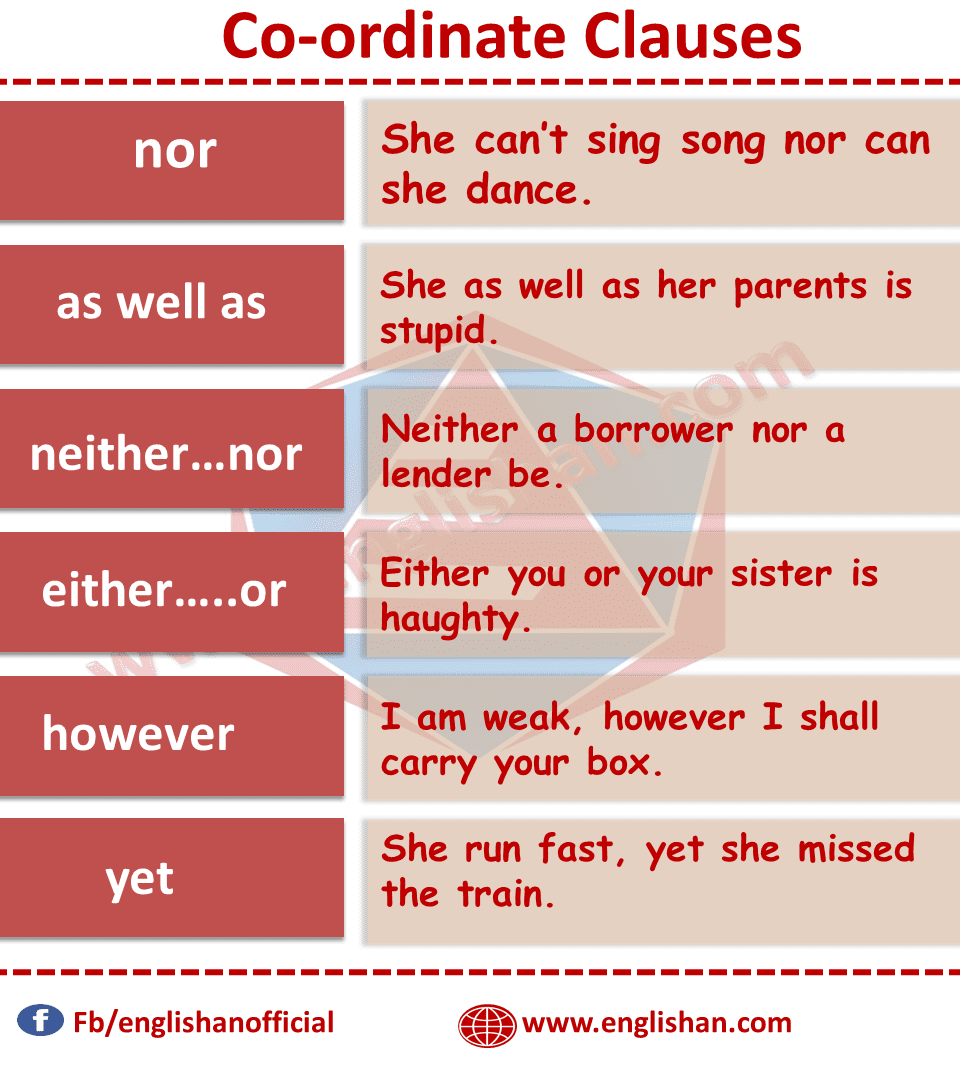
Kinds of connection between Co-ordinate Clauses
1: Copulative:
Examples:
- Gandhi was not only a good leader, he was also a reformer.
- She cannot sing nor can she dance.
- She as well as her parents is stupid.
- I took my lunch packet and boarded the bus.
In the above sentences, the italicized words (Co-ordinate Conjunctions) simply couple together two sentences.
Alternative:
Examples:
- Either you or your sister is haughty.
- Neither a borrower nor a lender be.
- Obey your teachers or you will repent.
- Walk fast; else you will not catch the bus.
In the above sentences, the italicized words (Co-ordinate Conjunctions) simply offer a choice between the clauses disjointed in meaning.
Adversative:
Examples:
- She is intelligent but slow-working.
- She ran fast, yet she missed the train.
- I am weak; however, I shall carry your box.
- Everybody cursed her; nevertheless, she did not come round.
In the above sentences, the italicized words (Co-ordinate Conjunctions) show contrast and are opposite in meaning.
Illative:
Examples:
- She didn’t show her homework, therefore, she was expelled from school.
- Her father is poor, so he cannot give a fat dowry.
- He missed the bus, for he did not run fast.
In the above sentences, the italicized words (Co-ordinate Conjunctions) join two clauses wherein the second clause draws inference from the first clause. Also observe the following sentences:
- He cursed his parents, which (and this) was wrong.
- She went to Agra, where (and there) she saw the Taj.
- Then he called on the Principal, who (and he) promised him to help.
In the above sentences the Co-ordinate clauses begin with Relative Pronouns (He/She) or Adverbs (Then). Here the Subordinate Conjunctions (which / where / who) are used in a continuative sense. Therefore, they introduce Co-ordinate Clauses and form a compound sentence.
Analysis of Compound Sentences
Definition: Analysis is the process of breaking up a sentence into its component parts.
Point to Remember. Analysis of a Compound Sentence
- Pick out nil the finite verbs to ascertain the number of clauses.
- Break up the sentence into clauses’.
- Write the ‘clauses in full (by supplying the missing verb or subject).
- Separate the connective.
- Show the function of each clause.
Example:
| He is strong but his dull. | ||
| He is strong(Principle clause) | He is dull (Co – ordinate clause) | But (connective) |
Subordinate Clauses (Complex Sentences)
The Noun Clause: A Noun Clause may be (a) Subject to a Transitive verb.
Observe the following sentences:
- That God exists everywhere is true.
- Why the old lady cursed him is known to me.
- When my father will return is uncertain.
In the above sentences the italicized words are the Noun Clauses. A Noun Clause always performs the function of a noun and answers the question. “What”?
The above sentences can be broken (disjoined) into clauses as follows:
- It is true (Principal Clause)
God exists everywhere. (Subordinate / Noun Clause)
That Conjunction
- It is known to me (Principal Clause)
The old lady cursed him. (Subordinate / Noun Clause)
Why Conjunction
- It is uncertain (Principal Clause)
My father will return (Subordinate/Noun Clause)
When Conjunction
- It is an open secret (Principal Clause)
She has got this job (Subordinate / Noun Clause)
How Conjunction
To find the Noun clause, we should ask questions like—
- What are true 2- is to me? 3. What is uncertain? 4. What is an open secret?
The answers to the above questions will locate the Subordinate Noun Clause. They stand as subject to the Finite Verbs ‘is, is known, is and is’ respectively.
Object to a Transitive Verb
Observe the following sentences:
- The beggar asked me if I could help him.
- Everybody knows why you are late.
- The teacher said that hard work is the key to success.
- She asked me if I would lend her a hundred rupees.
The italicized words in the above sentences are Noun Clauses because they answer the question “What”? They are joined by the connectives (if/why/that/if) and they are object to the verbs—asked, know, said and asked respectively.
Complement to an Incomplete Verb
Observe the following sentences:
- It seems that she is very selfish.
- My opinion is that we should quit this place.
- He found that his cash was missing.
- Everybody felt that the old man would not recover.
The italicized words in the above sentences are Noun Clauses because they answer the question. “What?” They are joined by the connectives (‘that’). They serve as complement to the verbs (seems, is, found and felt) preceding them.
Object to a Preposition
Observe the following sentences:
- There is no truth in what she says.
- I am surprised at what step she has taken.
- Don’t crave for what you cannot achieve.
- You must stick to what you have promised.
The italicized words in the above sentences are Noun Clauses. They serve as object to the prepositions ( in/at/for/to) preceding term.
Object to a Participle
Observe the following sentence
- Fearing that the wolf would kill the sheep, the shepherd boy began to cry.
- Seeing that the bear had gone away, the boy climbed down the tree.
The italicized words in the above sentences are Noun Clauses. They serve as objects to the participles (‘hoping/ hearing/fearing/Seeing’) preceding them.
Object to an Infinitive
Observe the following sentences:
- I want to know what help you expect front me.
- The girl was made to toil where she had stayed for the night.
- He was shocked to learn that his father had met with a serious accident.
- I want to ascertain whether you would accompany me.
The italicized words in the above sentences are Noun Clauses. They serve as objects to the infinitives (to know/to tell/to learn/to ascertain’) preceding them.
Apposition to a Noun or a Pronoun
Observe the following sentences:
- The saying that pride hath a fall is true.
- Then came the news that Mahatma Gandhi was shot dead.
- It is quite certain that she is not at home.
The italicized words in the above sentences are Noun Clauses. They stand in Apposition to a Noun {saying/news/ idea) or Pronoun {‘it’) preceding them.
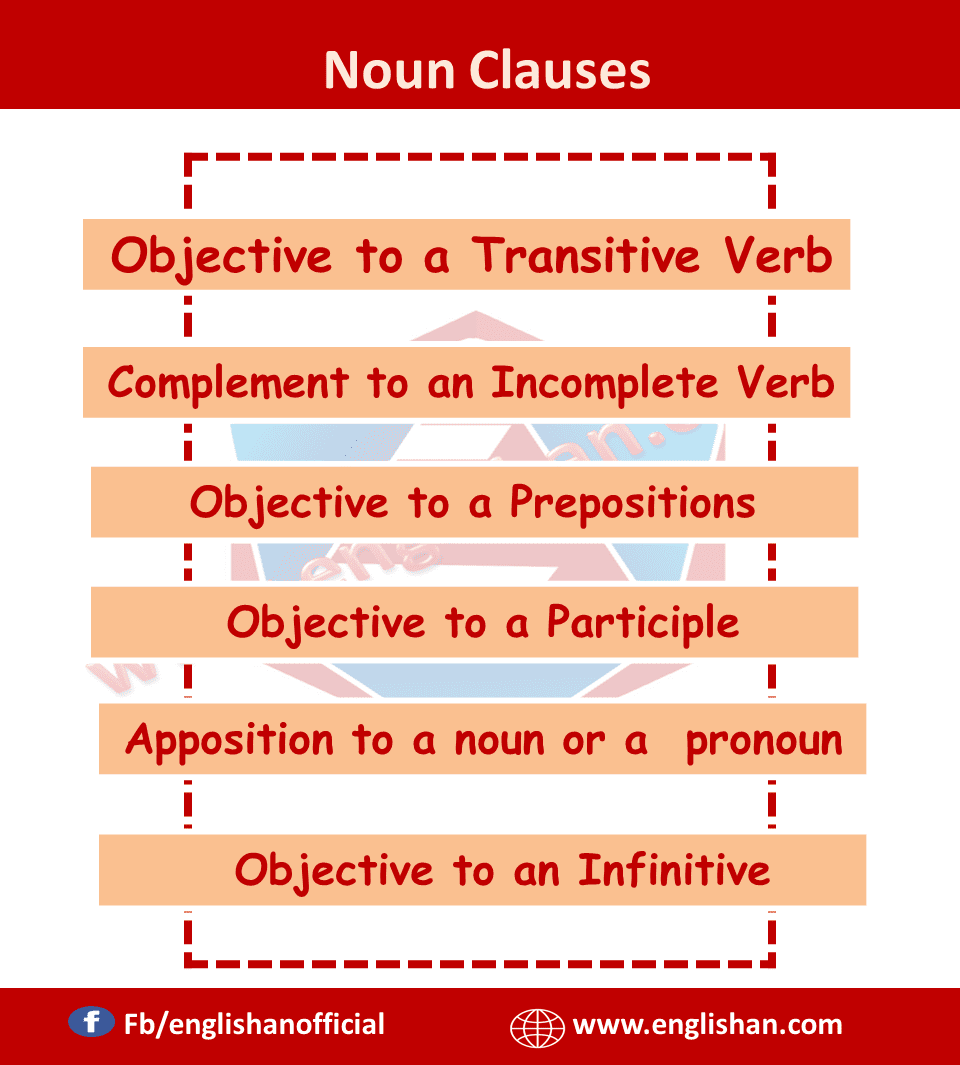
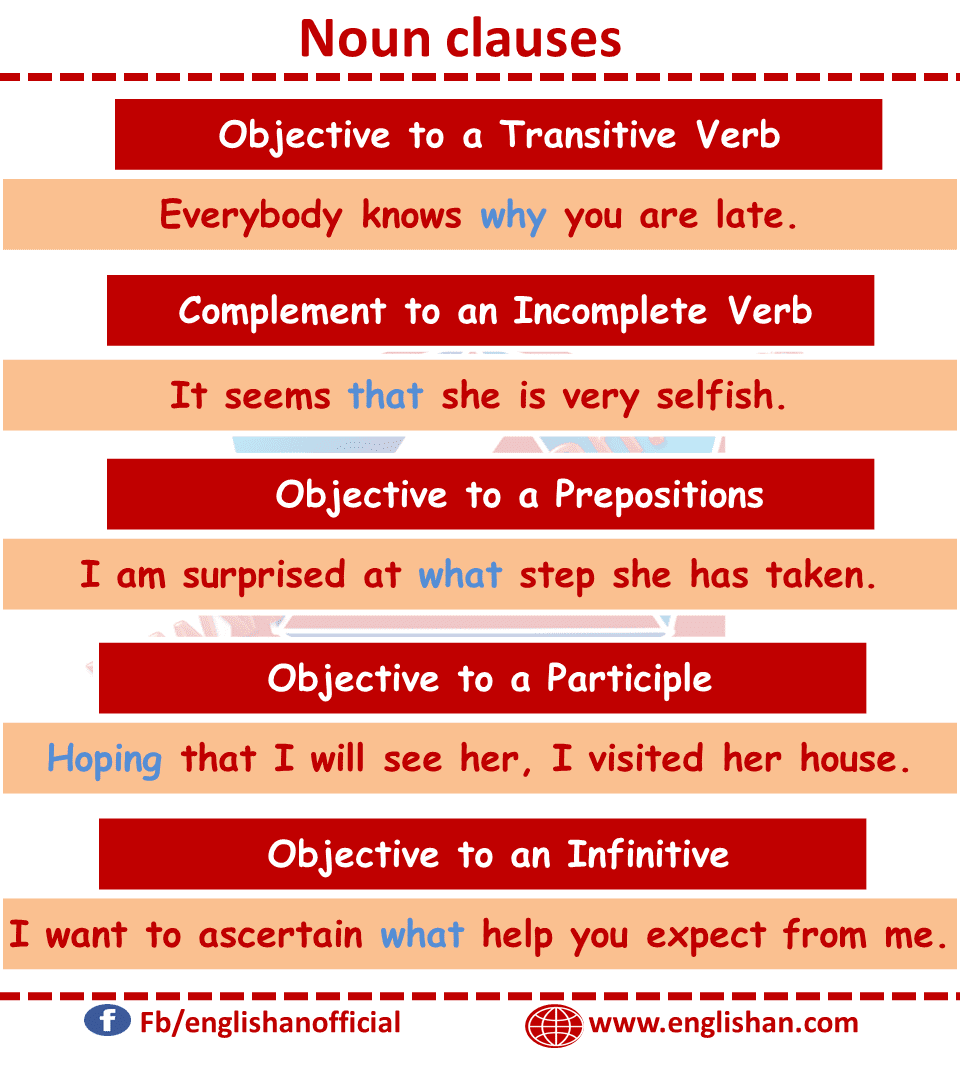
Adjective Clause
Definition: The Adjective Clause performs the function of an adjective to qualify a noun or pronoun of the main clause.
Observe the following sentences:
- This is the old man who stumbled against a stone.
- The elephant is an animal which has tusks.
- She is the girl whose husband divorced her.
- This is the place where my friend lives.
| Clause | Kind | Function |
| 1. (a) This is the old man | Main Clause | |
| (b)Who stumbled against | Adjectival Clause | Qualifying— ‘Old man’ |
| a stone | ||
| 2. (a) The elephant is an animal | Main Clause | |
| (b) Which has tusks | Adjectival Clause | Qualifying —’elephant’ |
| 3. (a) She is the girl | Main Clause | |
| (b) Whose husband | Adjectival Clause | Qualifying—’girl’ |
| divorced her | ||
| 4. (a) This is the place | Main Clause | |
| (b) Where my friend lives | Adjectival Clause | Qualifying —’place’ |
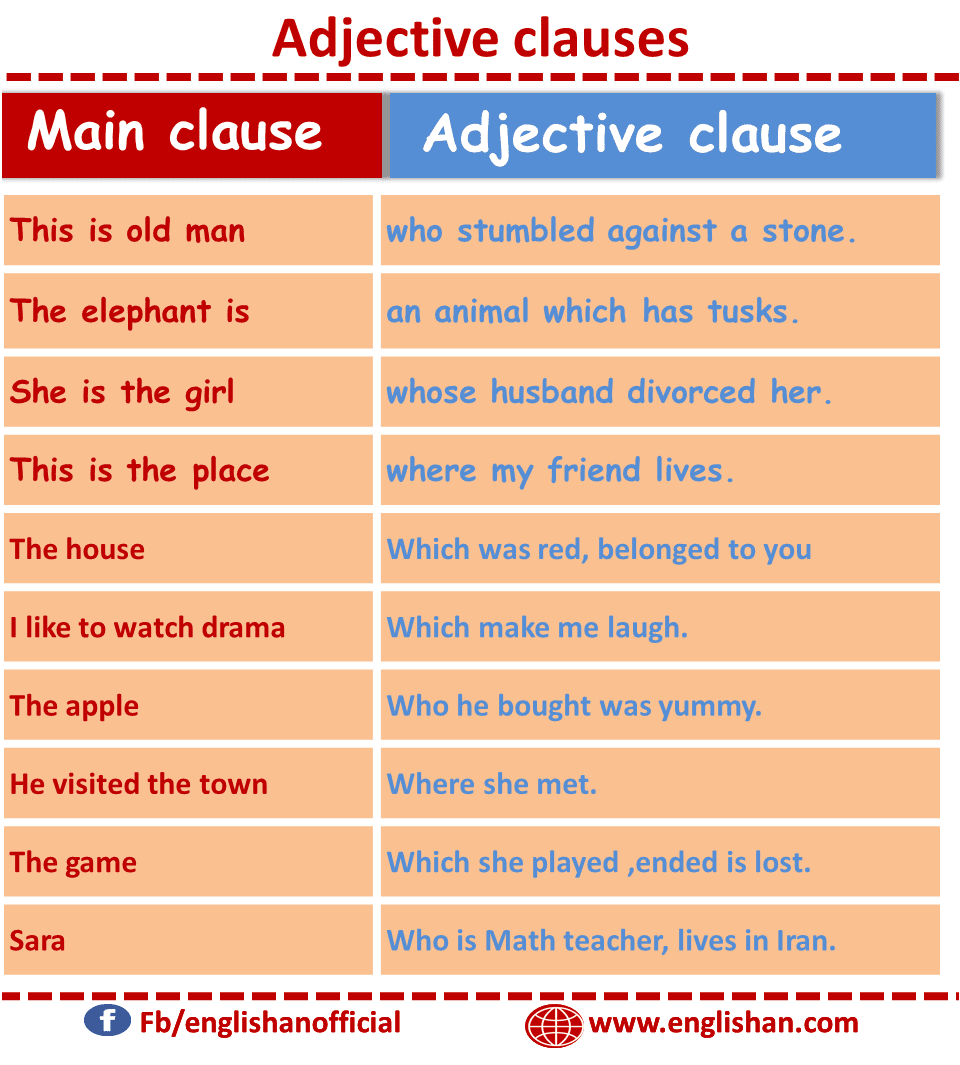
Adverb Clause
Definition: The Adverb Clause performs the function of an adverb. It can modify a verb, an adjective or another adverb.
Time-denoting Adverbial Clauses
observe the following sentences:
- All stood up even the President came.
- Wait here till I do not come back.
- She sang while I danced.
- ‘The doctor had reached there before the patient died.
- As the hot air cools, the balloon comes down.
The italicized words in the above sentences are Adverb Clauses. Their introducing words (‘when, till, while, before and as’) are time denoting adverbs. Some other time-denoting adverbs are: after, since, as soon as, whenever, as long as, so long as, etc.
Place-denoting Adverbial Clauses:
Observe the following sentences:
- She studies where I study.
- Live wherever you desire.
- She returned whence (from where) she had arrived.
- The soul has reached where from it might not return.
- The ship sailed whither the wind took her.
The clauses printed in italics in the above sentences point to the place where the action of the main clause takes place. They are Adverbial Clauses and serve as adverbs of places.
Manner-denoting Adverbial Clauses
Observe the following sentences:
- Try to finish it as she has shown you.
- He ran as if he were frightened.
- She behaved as though she were annoyed.
- I did according as I was directed.
The clauses printed in italics in the above sentences point to the manner in which the action of the Main Clause is done. They are Adverbial Clauses and serve as adverbs of manners.
Extent-denoting Adverbial Clauses
Observe the following sentences:
- So far as I know, she is a dullard.
- I cannot say how far I am correct.
- There was water and water as far as I could see.
- Can you tell me how long you will accompany me?
The clauses printed in italics in the above sentences point to the extent of the action (fact) mentioned in the Mam Clause. They are Adverbial Clauses and serve as adverbs of extent.
Reason or Cause-denoting Adverbial Clauses
Observe the following sentences:
- As she has been laid up with fever, she cannot take our class.
- She cannot sol re this sum, because she is dull in Mathematics.
- Since you recommend him, I am appointing him.
- I regret that I could not see you on the appointed day.
- Now that the sun has set, we should return home.
The clauses printed in italics in the above sentences point to the reason behind the action expressed in the Main Clauses. They arc Adverbial Clauses and serve as adverbs of reason/ cause.
Condition-denoting Adverbial Clauses
Observe the following sentences:
- We cannot get first division, unless we bum midnight oil.
- I will lend you the required money provided that you promise me to return it in time.
- I cannot let you in if you do not show me your identity card.
- In case you do not return the library books in time, you will be fined.
The clauses printed in italics in the above sentences point to the condition behind the action in/of the Main Clause. They are Adverbial Clauses and serve as adverbs of condition.
Contrast or Concession-denoting Adverbial Clauses
Observe the following sentences:
- He is miserly though he is rich.
- We must go although it is raining.
- Whatever you may say, I don’t believe a word of it.
- Even if she apologizes, I shall not visit her house.
The clauses printed in italics in the above sentences point to a contrast to the action expressed in the Main Clause. They are Adverbial Clauses and serve as adverbs of contrast/ concession.
Purpose-denoting Adverbial Clauses
Observe the following sentences:
- She works hard, so that she may get a scholarship.
- Keep awake lest somebody should get down with your luggage.
- You eat that you may live.
- I went to the post office in order that I might post the letter.
The clauses printed in italics in the above sentences point to the purpose behind the action expressed in the Main Clause. They are Adverbial Clauses and serve as adverbs of purpose.
Important Point about Adverbial Clauses: Some Grammarians treat the Extent-denoting Adverbial Clause at par with the Manner-denoting Adverbial Clause and Proportion-denoting Adverbial Clause.
| Subordinate Conjunctions Introduce Adverbial | Introduce Adverbial clause |
| When, whenever, after, before, while, as long as, as soon as, till, since, etc. | Time |
| Where, wherever, whence, whither, wherefrom, etc. | Place |
| that, in order that, lest, so that, etc. | Purpose |
| In case, if, unless, on the condition, provided that, etc. | Cause/reason |
| So…….. that, so, such, such that, etc. | Result/Effect |
| as … as, so … as, than, such as, no less than, etc. | Comparison |
| Even if, however, whatever, though, although, etc. | Concession/ Contrast |
| as, as if, as though | Manner |
| the…….. the, etc. | Extent |
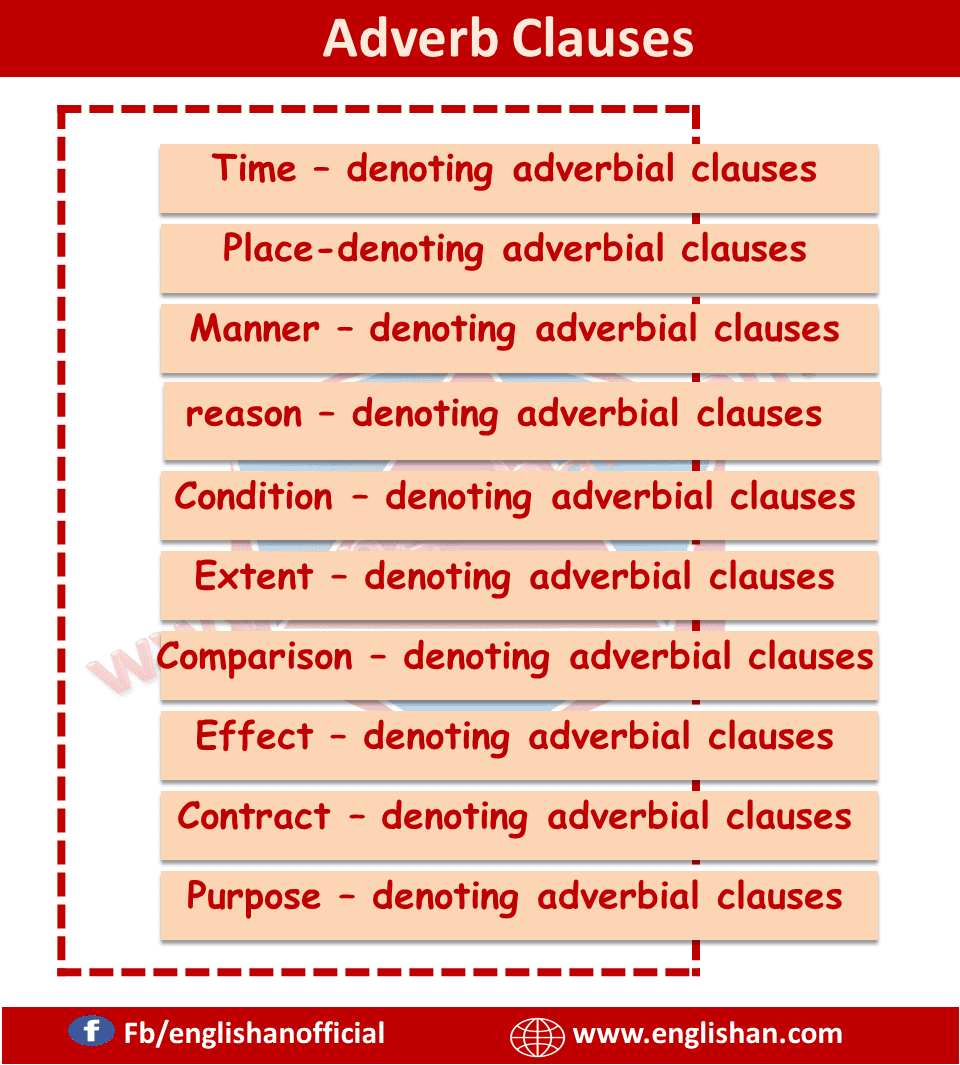
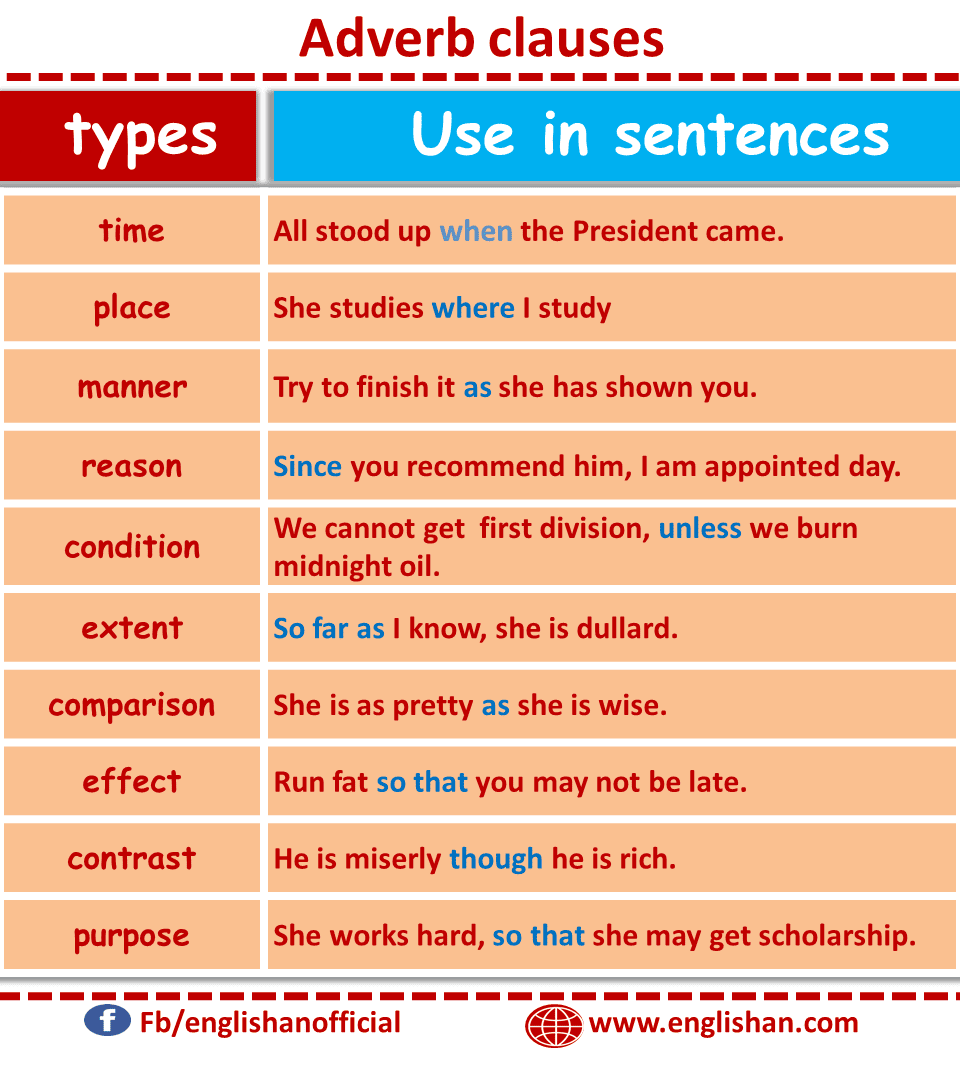
You May Also Like
- Adverbial Clauses in English
- Clauses and their Types
- Dependent Clauses
- Complex Sentences
- Independent Clauses


